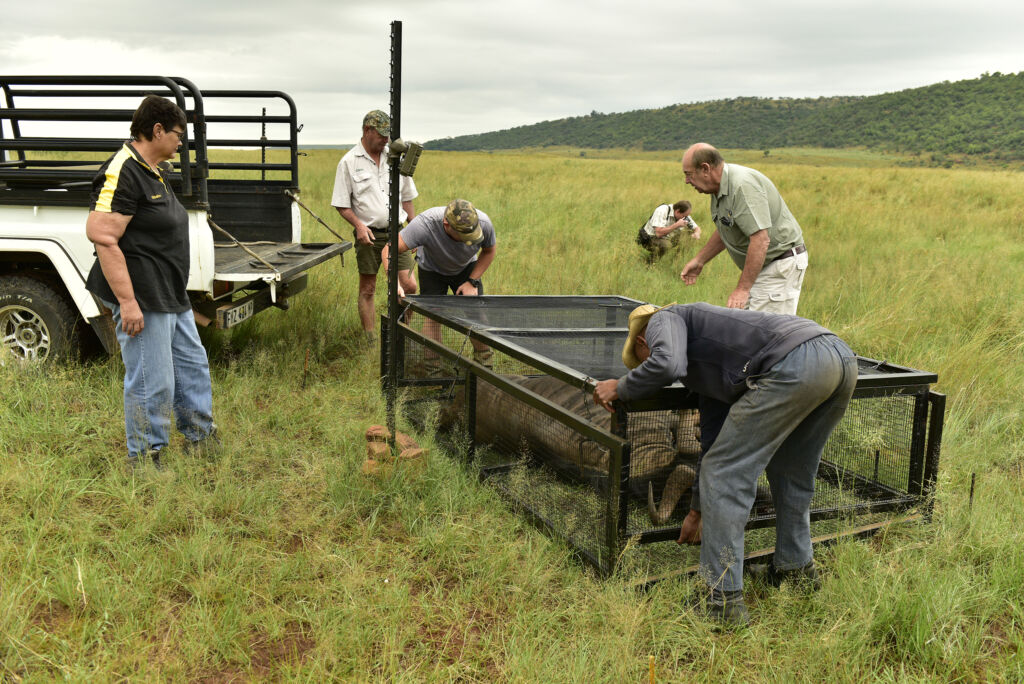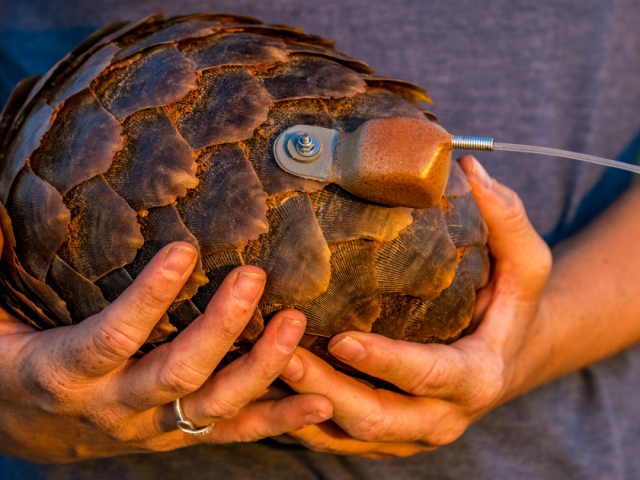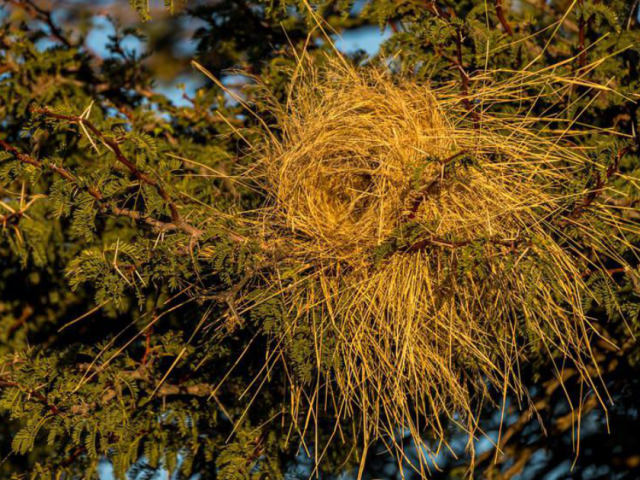Yves Vanderhaeghen interviews Dr Haemish Melvile, whose research suggests that animal carcasses can invigorate the environment.
Carcasses. What do they mean? It’s a question that preoccupies Dr Haemish Melville, a zoologist based out of the Applied Behavioural Ecology and Ecosystems Research Unit (ABEERU) at Unisa, who describes himself as “a bit of a mad individual” who is interested in “everything ecological. I’m interested in biosystematics, population dynamics and all those good things”.
At his research site at Telperion Nature Reserve in Mpumalanga, between Witbank and Bronkhorstspruit, “those good things” all revolve around blue wildebeest carcasses. While his background is in the study of (live) meso-predators – caracal, bobcat, coyotes, raccoon – his particular interest now is decomposition ecology.
This Carcass Project “is a monster project”, says Dr Melville, but “it’s something I sort of fell into”. “You push around in the bush quite a bit and you see carcasses, and then you see animals feeding on them, but you think, what do they mean? No one has really taken the time to see what the ecological implications of these carcasses are. Very little has been done in South Africa. And certainly not in terms of a structured experimental study. There have been ad hoc studies on single carcasses, or pieces of carcasses, but nothing that has documented the process from mortality through to a year post-mortality. And that’s what we’ve tried to do.”
To cover the various aspects of this process he has a number of collaborators (Professor L. Brown (ABEERU), Dr W.M. Strauss (ABEERU), Dr K. Slater (ABEERU), Dr A. Barret (ABEERU), Dr L. Richards (Durban Museum of Natural History), Professor V. Ngole-Jeme (UNISA), Dr M. Deutschlander (UNISA), Professor M. Villet (Rhodes University) and Dr K. Williams (KwaZulu-Natal Museum) and postgraduate students on the team: “One on soils, one on scavengers, one on bats, one on soil microbes, one on vegetation”.
Dr Melville summarises the key research question as: “What is the impact of a carcass on an ecosystem. It’s effect is more than merely death and providing fodder for scavengers, or for vultures. How does it potentially affect the system on a broader scale. And without putting the cart before the horse, what are the broad-spectrum ecological effects: does it nutrify the soil; what are the implications of that; does that nutrified soil lead to changes in microbiota; does the change in nutrient value change the vegetation composition or the plant composition and vigour … It’s looking to establish what the biosystematics implications of a carcass are in a landscape.”
The carcasses Dr Melville and his team are studying are from a cull of old animals on the reserve, which supports a variety of grasslands species and predators including brown hyena, black-backed jackals and leopard.
He says “We thought the wildebeest would be a good general example of a typical grassland ungulate. I thought it unlikely that given the predators on the reserve that the carcasses would be consumed rapidly, and that they would be a good starting point for us, because this is very much a pilot study.” The study included carcasses in exclosure cages “so scavengers couldn’t get at them”, and which were weighed weekly as they decomposed, but some carcasses were left out in the open for scavengers to get at.
He notes that in Europe and America “the preponderance of carcasses are not as a result of predation. They’re the result of either malnutrition, natural mortality, starvation, disease”. However, in Africa, “where you have intact systems like in Kruger and Serengeti, and where you’ve got the full spectrum of predators and you’ve got vultures, you’ll probably find that everything up to and including the size of a buffalo, is probably consumed fairly rapidly.
But on our smaller reserves, where you don’t have the full spectrum of predators, you’ll probably find that carcasses are not consumed completely, and those carcasses may result from culling, or incidental mortalities, but unlikely to be exclusively the result of predation.”
Telperion falls within the category of a smaller reserve. A grasslands ecosystem, “it’s representative of a lot of reserves that we have in South Africa, in so far as it’s an island in a matrix of farming and mining, says Dr Melville.
He is cautiously optimistic about what they have seen. “I’d be lying if I said carcasses are the be-all and end-all, but what we are seeing evidence of is that even relatively small carcasses have a substantial influence on the ecosystem, and may have value, or create heterogeneity in the areas where they fall, if left to decompose.”
How then should an ecosystem look if the process of decomposition of carcasses does what it should, through all its elements?
“The idea would be: an animal dies; the process of decomposition starts taking place; those nutrients ultimately filter into the soil, whether it’s through scavengers and defecation or ultimate mortality of the scavengers, or whether it’s the breakdown of that carcass in situ, and whether that’s vertebrate or invertebrate breakdown. If invertebrates (insects) start consuming it they either fly off or die in situ, and those nutrients pass into the soil there and then or they get dispersed.
That’s the starting point. Beneath the carcass, those nutrients flow into and nutrify the soil. The degree to which they nutrify the soil is purely dependent on the size of the carcass and the degree to which the flesh and bone and skin is removed by vertebrates or invertebrates. So if you’ve got a lot of material there that persists over a long time it breaks down and nutrifies the soil.
The consequence of that is that it either toxifies the soil by hyper-nutrifying the local area and then over a period of time that hyper-nutrification declines through leaching, so the nutrient load declines and then eventually it becomes a substrate in which plants can survive. Or, if it doesn’t toxify the soil, it is a nutrient rich environment in which plants survive and grow. In addition to which there is a very rapid response in the soil microbes. There’s a rapid amplification both in terms of number and diversity of soil microbes immediately, and that adds to the soil dynamics and the soil biotic community.
“Moving on from that, the plants either grow vigorously or not, depending on the level of nutrification and the type of plants. And then over a period of time, the probability is that if those are nutritious plants with high nutritional value you would expect that herbivores would preferentially feed on those plants. And if they defecate where they feed then that nutrient rich zone may propagate outwards or lead to the creation of grazing lawns where single plant species dominate. But that hasn’t been verified yet.”
In reality the carcass is not left to its own devices, slowly to percolate down as it decomposes. Scavengers, of all kinds, play a vigorous role in disposing of a carcass.
There’s direct scavenging, says Dr Melville, “which is using the flesh of the carcass directly”, or “secondary resource use, which would be feeding on those invertebrates which are attracted to these carcasses. So we’ve found that things like toads and birds and bats feed on the invertebrates associated with the carcasses.”

What kind of application could come out of the research if conclusions are as hypothesised?
Says Dr Melville: There’s a good management application if one takes as a point of departure that most game farms in South Africa are on degraded land that has either been heavily used for agriculture or for stock farming and the nutrients have quite possibly been depleted. So there may be a management application in that if there is a cull, several of those carcasses be left in situ to generate these nutrient rich hotspots. Culls would normally be given to the community, or be shipped off as meat. Some of the cull would go to biltong hunters, who would remove the carcass. It would be very unlikely that those carcasses would be left on the ground.
So it wouldn’t necessarily be a very popular decision either financially or in terms of community relations?
“No, quite correct. But we’re looking at how we promote ecosystem processes as opposed to just financial implications. But you may find that the nutrient value that is generated from the carcasses may be only realised over several years, by an increased ability to support larger stock numbers, or having healthier animals.
In that sense would the practice fall within a regenerative framework?
“Absolutely. It’s very much an ecological application, an ecosystematic approach which is understanding how an ecosystem works on a micro scale, because all the systems happen at that local node, and you can make predictions based on it. Maybe not in terms of your smaller carcasses, but when you move up to your giraffe or other mega herbivores their carcasses may well have substantial ecosystem effects. Then it has not only a local impact but a broad spectrum impact.”
The research has thrown up some unexpected findings, not directly related to decomposition ecology. “One of the highlights” says Dr Melville, “which we will be reporting on shortly, is that jackals simply cannot get into a wildebeest carcass without help. We put these carcasses out, and until the invertebrates had made inroads and lesions in the skin, the jackals couldn’t get into those carcasses, despite what people say. They tried to get through the skin, and they just couldn’t do it.
That suggests that, in African systems, it may be that jackals require some sort of facilitation to get into larger carcasses. So these systems have probably evolved with the larger predators and vultures facilitating access for the smaller predators.”
He adds that “something else we’re going to report on now is secondary facilitation, so although jackals can’t get into the carcasses, they are feeding on the invertebrates such as flies and beetles around the carcasses. That’s interesting and hasn’t been reported on.”
A third unexpected element to come out of the research was how small mammals behave around a carcass. “One of the things we looked at is if smaller mammals responded behaviourally to carcasses, but more specifically to an increased threat of predation, because one would expect that in an area where there is an increased number of predators.”
In general, says Dr Melville, one would expect “preferred prey for mesopredators like black-backed jackals, in this case small mammals, to make themselves scarce or avoid areas where there is a threat of predation. But although that is what we hypothesised we found completely the opposite. It may be unique to Telperion, but because the small mammal assemblage there is largely insectivorous or omnivorous, they started increasing their activity around carcasses, and we suggest that that is because they were feeding off the invertebrates drawn by the carcases.”
Animals on the look-out for food, says Dr Melville, are constantly doing a cost-benefit analysis: “what is the threat I’m exposing myself to from the prey point of view, or even from the predator point of view, and what is the benefit that I’m getting?”
Why then would the animals behave differently to what he expected?
“It could suggest that this is a resource-scarce environment and that the benefit of this bonanza is worth the risk. Animals do respond behaviourally to resources – fruit bats and fruiting trees, birds and eruptions of termites.” But there may also be a hidden hand at play: “It’s true that on a reserve the resource is probably influenced by the management structure, in terms of the size of reserve and the number of animals on it,” says Dr Melville.
Dr Melville acknowledges that the study of stinking rotting carcasses is not to everyone’s taste, and as a result the project was “quite out there” as a funding candidate. This is of course no small matter, because doing science can be very expensive.
“Most funders,” says Dr Melville, “like something which is going to generate interest, which is cute, which is cuddly, where there is some form of human affinity or some form of emotional hook.
“This type of research is completely unemotional, looking at animals as very much part of a larger system, as an initiation node for larger ecological processes. So, the questions we are asking are more ecosystematic, rather than looking at behaviour and those type of (sexy) questions.”
He emphasises that “the sheer cost of conducting these studies is substantial, and I don’t think funding agencies have a grasp on what it costs”. Equipment alone “can run into the several hundreds of thousands of rands. That’s before you’ve got vehicles, fuelled them, before you’ve done anything. For this carcass project, the exclosure cages and the weighing platforms ran to about R70 000. The camera traps: R150 000, before you’ve put batteries in them, or SD cards. Small mammal traps, 30 of them per site, are R500 a shot. So you’re talking half a million rands just in equipment. Just to set up. Before you’ve got anything going. And that is a relatively smallscale project. You’re not looking at anything hugely sophisticated.”
Who stumped up for the project then?
Mainly Oppenheimer Generations Research and Conservation (funding and research support), ABEERU (funding, equipment, vehicles, fuel and accommodation) and Unisa (funded some of the cameras). “The cost of the field component would run at about half a million rands if not more. Then there is students’ time, registration fees etc,” says Dr Melville.
He adds that it would not be atypical for a project to cost in excess of R1 million to R1,5 million, and, “to give you an example of the PhD student who’s running after caracal and jackal (on a farm in the Eastern Cape), those costs are R2,3 million.”
The Carcass Project is not the only thing, apart from lecturing, that Dr Melville is involved in. He has a PhD student working on jackal and caracal, a researcher looking at the ecology of termites (also at Telperion), he’s analysing data on spotted hyena “running around on Tswalu” in the Kalahari. And then he has a team “looking at small mammal vocalisations and trying to see if we can identify individual species through ultrasonic calls, much like you do with bats”.
And then there’s a whole bunch more, “so I don’t have a lot of time to scratch my bum”, says Dr Melville.
Yves Vanderhaeghen writes for Jive Media Africa, science communication partner to OGRC.
- Tracking the Shangani Wanderer - June 18, 2025
- Rescue, rehabilitate, release: tracking the comeback of South Africa’s pangolins - June 18, 2025
- Fewer weavers, fewer homes: why nest builders matter in the Kalahari - June 17, 2025
Additional News
Pangolins are elusive and heavily trafficked. At Tswalu, researchers are working to uncover their secrets and aid conservation.
Declining Sparrow-Weavers may threaten other birds that rely on their old nests for shelter.





